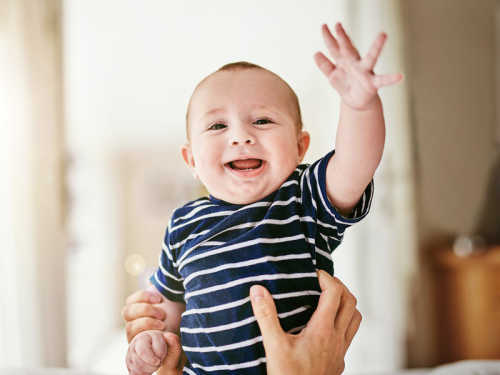Your child safety guide
Written by Dr Martin Bailey | Paediatrician
Tags: ChildcareFirst AidHealth and WellnessSafetySwimmingToysTravel
Keeping your baby safe at home becomes more challenging as he or she learns to move. Start getting prepared by child-proofing the nursery, kitchen, bathroom and even the car with these handy tips, from Nubabi’s paediatrician, Dr Martin Bailey.
Changing time
- Make sure the nappy changing surface is big enough.
- Have a foam rubber changing mat cut to size and covered. Design this with raised sides so that baby lies comfortably in the U-shaped hollow in the middle, and there’s no risk of her/ him falling off it.
- Keep toiletries out of baby’s reach but within yours. Never leave baby unattended.
Bathtime
- Fill bath tub just enough to cover baby’s legs.
- Use warm, not hot water, and always test it on your own skin first.
- Never leave baby in the tub alone – not even for a few seconds.
- Put non-slip mats in the bathtub and on the floor next to the tub.
Bedtime
- Don’t use drop side cots.
- Avoid using fluffy bedding such as pillows, comforters or sheepskins under sleeping or napping babies.
- Don’t leave toys in the crib when baby is sleeping.
In the kitchen
- Never carry hot food or drink and your baby at the same time.
- Keep hot food and drink away from edges of tables and counters.
- Don’t hold baby while cooking at the stove.
- Rotate pots so that handles are pointed to the back of the stove.
Around the house
- Cover plug outlets with safety plug covers.
- Keep dryers, toasters and other appliances unplugged and out of reach.
- Use door stops or door holders to protect baby’s fingers.
- Install safety gates to secure dangerous areas e.g. staircases.
- Secure furniture that can topple (e.g. bookcases) to the wall.
- Anchor flat screen TV’s securely.
- Place tall, unstable lamps behind furniture.
- Move all household chemicals, garden poisons, cleaning agents, medicines, toiletries, and mothballs to secure cupboards and lock them.
- Get rid of toxic houseplants. (Some examples are: Oleander, peace lily, caladium.)
Toys
- Ensure there are no buttons, beads, ribbons or loose pieces on toys that baby can pull off and choke on.
- Ensure there are no sharp edges or peeling paint.
In transit
Road traffic accidents are the leading cause of death from injury among under-fives in South Africa. Many of these deaths, and many more devastating injuries, are to children who were not strapped up in baby car seats.
And don’t think you will be able to hold your baby safely in a car: Says Professor Sebastian van As, head of trauma at the Red Cross War Memorial Children’s Hospital in Cape Town, and chair of the child protection organisation, Childsafe: “Even going as slowly as 40 kilometres an hour, the weight of a child is multiplied by 50 times when the car is moving. So, if your baby weighs 10 kilograms, in a crash, the baby becomes 500 kilograms of weight when he is propelled forwards. There is no one in the world who can stop 500 kilograms flying forwards.”
- Keep children in a rear facing car seat until 2 yrs of age. (This is a new recommendation from the American Academy of Paediatrics.)
- South African law now stipulates that that all children under the age of three must be in age-appropriate car seats.
Water
A small child can drown in only 4cm of water within 30 seconds, according to the Children’s Hospital Trust. This means that everywhere water collects is a hazard: buckets, drains, dog’s bowls, toilets, fishponds, inflatable play pools or ‘clam shell’ pools. It takes only 4 minutes without oxygen for irreversible brain damage to occur. Practicing water safety is the most important way to prevent any water incidents:
- Make sure any bodies of water are secure.
- Cover swimming pools with a recognised and reputable secure pool cover and secure access points, preferably with a lockable gate.
- Close adult supervision – meaning close enough to touch – is the only way to ensure your child’s safety near water. Children cannot be expected to supervise other children.
- Teach your child to swim, but don’t rely on that for safety. Former emergency services paramedic, and first aid trainer, Charlene van Tonder says: “Many of the children who drown each year can, in fact, swim.”
- If your child is in trouble in the water, seek help immediately. Approach him and grab a piece of his clothing and pull him out of the water carefully. If the child is not breathing, he will need CPR immediately.
- First aid training is essential for parents and any regular caregivers.
- Many submersion accidents are associated with neck injuries, so keep movement to the back and neck to a minimum.
- Drowning is always an emergency. Call an ambulance for a water-related medical emergency.
Share this
- 0
- 0
Related Posts
Have you tried the Nubabi Free Trial?
Get unlimited access to Your Parenting Toolkit for 2 weeks for free!
Track, Boost, Explore and Capture your child's growth and development.
Available on both mobile and web.


